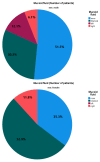Clinical Decision Making for Intraoperative Auditory Brainstem Response Testing in Children following Tympanostomy Tube Placement
- PMID: 36769478
- PMCID: PMC9917660
- DOI: 10.3390/jcm12030830
Clinical Decision Making for Intraoperative Auditory Brainstem Response Testing in Children following Tympanostomy Tube Placement
Abstract
Intraoperative auditory brainstem response (ioABR) testing following tympanostomy tube (TT) placement may be biased due to temporary threshold shifts (TTS). The purpose of the study was to assess the evidence for TTS in children who have undergone ioABR using prolonged latencies of wave I (males > 1.95 ms, females > 1.88 ms) as a marker of a persisting air-bone gap. Eighty-three children underwent ioABR following surgical procedures at University Hospital Bonn, Germany. The primary outcome measure was the latency of wave I at 80-dB SPL. The total sample consisted of 66 males (79.5%) and 17 females (20.5%) with a mean (SD) age of 46.4 (26.6) months. Of 163 operated ears (83 children), 72 (44.2%) had no middle ear fluid, 19 (11.6%) serous fluid, and 72 (44.2%) mucoid fluid. The risk of having a prolonged latency of wave I at 80-dB SPL was OR 4.61 (95% CI 2.01-10.59; p < 0.001) in those with mucoid fluid as compared to those without mucoid fluid. Intraoperative ABR results should account for sex differences and be interpreted with caution and be verified. Ultimately, parents should be engaged in a preoperative discussion to decide if an ioABR should be postponed if mucoid fluid was found.
Keywords: auditory brainstem response; myringotomy; otitis media with effusion; temporary threshold shift; tympanostomy tube.
Conflict of interest statement
The authors declare no conflict of interest.
Figures



Similar articles
-
Effect of Tympanostomy Tube Placement on Intraoperative Auditory Brainstem Response.J Am Acad Audiol. 2021 Feb;32(2):70-75. doi: 10.1055/s-0040-1718933. Epub 2020 Dec 9. J Am Acad Audiol. 2021. PMID: 33296931
-
Audiologic Profiles of Children With Otitis Media With Effusion.Ear Hear. 2021 Sep/Oct;42(5):1195-1207. doi: 10.1097/AUD.0000000000001038. Ear Hear. 2021. PMID: 33974785 Free PMC article.
-
Brainstem auditory evoked potentials in young children before and after tympanostomy tube placement.Int J Pediatr Otorhinolaryngol. 1993 Jan;25(1-3):105-17. doi: 10.1016/0165-5876(93)90014-t. Int J Pediatr Otorhinolaryngol. 1993. PMID: 8436453
-
An Overview of the Tympanostomy Tube.Cureus. 2022 Oct 11;14(10):e30166. doi: 10.7759/cureus.30166. eCollection 2022 Oct. Cureus. 2022. PMID: 36397911 Free PMC article. Review.
-
Tympanostomy tubes: patient selection and special considerations.Pediatric Health Med Ther. 2015 May 6;6:41-43. doi: 10.2147/PHMT.S61938. eCollection 2015. Pediatric Health Med Ther. 2015. PMID: 29388576 Free PMC article. Review.
References
LinkOut - more resources
Full Text Sources
Miscellaneous

